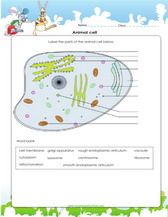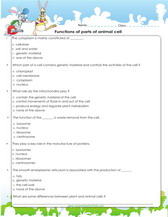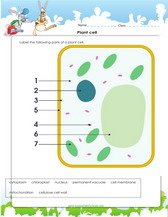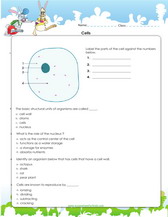Plant Cell Coloring: Exploring the Green Universe
Plant cell coloring is a fascinating educational activity that allows individuals to explore the intricate structures within plant cells in an engaging and creative manner. By using various coloring techniques, individuals can visualize and understand the different components that make up a plant cell.
Importance of Understanding Plant Cell Structure
Understanding the structure of plant cells is essential for grasping fundamental concepts in biology. Plant cells possess unique organelles and structures that play crucial roles in processes such as photosynthesis, nutrient storage, and cell division. By familiarizing themselves with plant cell structure through coloring, students and enthusiasts can enhance their comprehension of biological concepts.
Learn about the functions of the nucleas, cell wall, membrane etc
Learn to label the parts of a plant in this pdf worksheet, pdf printable for kids.
Learn to label parts of a cell and learn about cell characteristics
Learn to label the parts of a plant in this pdf worksheet, pdf printable for kids.
Components of a Plant Cell
-
Cell Wall : A rigid outer layer that provides structural support and protection to the cell.
-
Cell Membrane (Plasma Membrane) : A semi-permeable membrane that regulates the movement of substances in and out of the cell.
-
Cytoplasm : A gel-like substance that fills the cell and contains organelles, enzymes, and other cellular structures.
-
Nucleus : The control center of the cell, containing genetic material (DNA) responsible for regulating cell activities and inheritance.
-
Nuclear Envelope : A double membrane that surrounds the nucleus, controlling the passage of materials between the nucleus and the cytoplasm.
-
Nucleolus : A dense region within the nucleus where ribosomal RNA (rRNA) synthesis occurs and where ribosomes are assembled.
-
Chloroplasts : Organelles responsible for photosynthesis, containing chlorophyll pigments that capture light energy to produce sugars.
-
Mitochondria : Organelles responsible for cellular respiration, converting energy stored in nutrients into ATP (adenosine triphosphate), the cell's primary energy source.
-
Endoplasmic Reticulum (ER) : A network of membranes involved in protein and lipid synthesis. Rough ER is studded with ribosomes, while smooth ER lacks ribosomes and is involved in lipid metabolism and detoxification.
-
Ribosomes : Small organelles responsible for protein synthesis, either attached to the rough endoplasmic reticulum or free-floating in the cytoplasm.
-
Golgi Apparatus : A stack of membranes that modifies, sorts, and packages proteins and lipids for transport within the cell or secretion outside the cell.
-
Vacuole : A large, fluid-filled sac in plant cells that stores water, nutrients, and waste products. It also helps maintain turgor pressure, contributing to cell rigidity.
-
Plasmodesmata : Cytoplasmic channels that traverse the cell walls of plant cells, allowing for communication and transport of materials between adjacent cells.
-
Microtubules and Microfilaments : Cytoskeletal components involved in maintaining cell shape, cell division, and intracellular transport.
These are the primary components of a plant cell, each playing crucial roles in the cell's structure, function, and overall health.
Significance of Each Component
Each component of the plant cell contributes to its overall function and survival. For example, chloroplasts enable plants to produce their own food, while vacuoles store essential nutrients and maintain turgor pressure.
Techniques for Plant Cell Coloring
There are various techniques for coloring plant cells, including watercolor, colored pencils, markers, and digital tools. Each method offers unique advantages in terms of precision, detail, and artistic expression.
Tips for Accurate Plant Cell Coloring
When coloring plant cells, it is essential to refer to accurate diagrams or illustrations to ensure the correct depiction of cellular structures. Additionally, using vibrant colors can help differentiate between organelles and highlight their importance.
Educational Benefits of Plant Cell Coloring
Plant cell coloring serves as an effective educational tool for students of all ages. It promotes active learning, improves visual-spatial skills, and enhances retention of scientific concepts. Furthermore, it encourages creativity and artistic expression while reinforcing biological knowledge.
Fun Activities for Plant Cell Coloring
In addition to traditional coloring exercises, there are numerous fun activities that incorporate plant cell coloring, such as crossword puzzles, quizzes, and interactive online games. These activities make learning about plant cells enjoyable and engaging.
Plant Cell Coloring Resources
There are abundant resources available for plant cell coloring, including coloring books, printable worksheets, and online tutorials. Educators and parents can utilize these resources to facilitate hands-on learning experiences and supplement classroom instruction.
Conclusion
Plant cell coloring offers a captivating way to explore the intricate world of plant biology. By immersing oneself in the colorful realm of plant cells, individuals can gain a deeper understanding of their structure, function, and significance in the natural world.
FAQs
-
Why is plant cell coloring important for students? Plant cell coloring enhances visual comprehension and reinforces scientific concepts in a creative manner, making it an effective educational tool for students.
-
What are some recommended coloring techniques for plant cells? Watercolor, colored pencils, and markers are popular choices for plant cell coloring due to their versatility and ability to produce vibrant results.
-
How can parents incorporate plant cell coloring into homeschooling activities? Parents can integrate plant cell coloring into science lessons by providing coloring worksheets, conducting hands-on experiments, and exploring related topics through discussion and exploration.
-
Are there online resources available for plant cell coloring? Yes, there are numerous online resources offering printable coloring pages, interactive tutorials, and educational videos on plant cell structure and function.
-
Can plant cell coloring be beneficial for adults? Absolutely! Plant cell coloring can be a relaxing and therapeutic activity for adults, providing a creative outlet while fostering a deeper appreciation for the complexities of plant biology.















